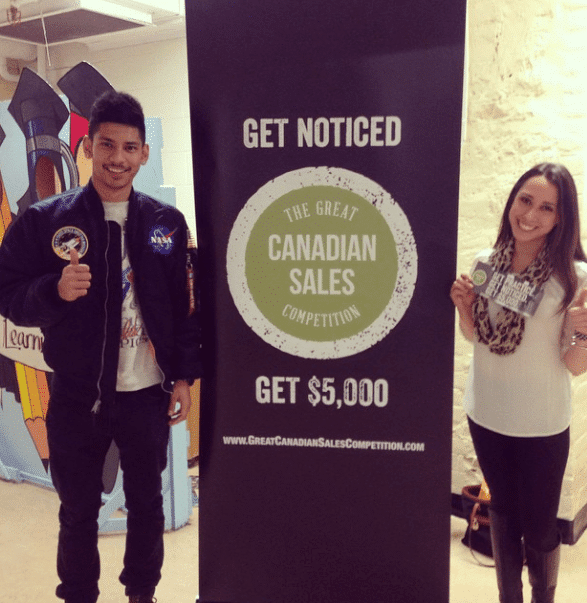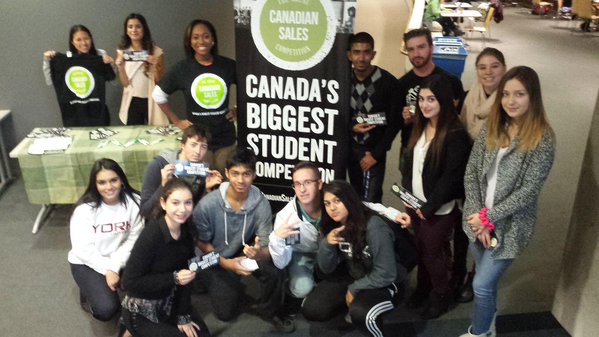
The Competition Team at George Brown College
In its first year of execution, The Great Canadian Sales Competition attracted 215 students from 6 provinces and 33 different schools. We were thrilled with the results – we took a program that no one had ever heard of before and got it off the ground. As the Competition Director, I spent a lot of time on campus with any help I could find. I remember setting targets for our pseudo-teams while on campus, and our team being thrilled if we could get more than just a handful of students participating during one of our school visits. I was confident in saying that we got the Competition off the ground in its first year, but now we all wanted to see it claim the title of Canada’s Biggest Student Competition. So, going into our second year, we came to the table with very lofty targets, which included:
- 500+ contestants (233% increase)
- 50+ schools (151% increase)
- 25 Sponsors (10% increase)
Sales Talent Agency, founding partner of The Great Canadian Sales Competition, can be described as an organization that historically sees a wall and runs through it. I’ve been mentored to believe that no task is ever too big to conquer, but even I’ve got to admit that these targets felt daunting. I knew that in order to be successful in its second year we had to delegate, and anyone who is familiar with the Type A personality knows that delegation is our Achilles heel to leadership. How were we going to start a program that attracts more competitors and engagement, with the same level of control we had in the first year by virtue of doing it ourselves? This question sparked hours of discussion and resulted in the development of our Ambassador Program.
The Ambassador Program involved hiring 100+ students across the country that would be responsible to promote the Competition on campus and encourage students to participate. The Great Canadian Sales Competition is a 3-round competition:
- Round 1 tasks students to pitch a 30-90 second video on anything they want
- Round 2 tasks the Top 25% of students to pitch one of sponsors in a 1-2 minute video and
- Round 3 tasks the Top 25 students to manage a sales meeting in front of a panel of judges in Toronto, ON.
The 1st place prize is $7,500 and 2nd, 3rd, 4th and 5th place win $1,000. When we hired our team of Ambassadors over the summer, each of them thought the task to promote this Competition on campus sounded “almost too easy” as the prizes, opportunity, sponsors, and scope is a seemingly easy sell. The reality is that when you ask a student to step outside of their comfort zone – and let’s be honest, pitching a topic on a camera in front of strangers is way outside of your comfort zone – students are not lining up by the dozens to participate. Our Ambassadors worked with our competitors to understand the importance of a sales pitch and how best to craft one together. They spent an average of 30+ hours on campus promoting the Competition to their peers and to people they had never met before. They got people rethinking sales as a profession and chipped away at the common misconceptions about sales as a discipline. They got students thinking about companies that they may not have heard of or previously considered as potential employers. And finally they made students feel comfortable enough to not only step outside of their comfort zone, but so comfortable in fact that many of our participants pitched their idea on video right there on the spot. When we started the Competition, we hoped that we would bring in 500 competitors, which would have doubled what we did last year. I know that there is no way we would have been able to bring in the results we saw without the drive and determination from our Ambassador team.
Reflecting back, we hit the nail on the head on so many things, and – as always – have some lessons learned for next year. Below are our major take-a-ways on the program, and things to definitely take into consideration if you are in the process of designing on on-campus program.
The students you want to work for you already have a ton of accolades on their resume, so what makes your opportunity different?
When designing this program, I had three interns over the course of the program who brought in a very interesting perspective as they were all students and also the program’s first hires. We were all in agreement that the program needed to be paid, but what beyond that would incent students to participate?
When we started interviewing our Ambassadors, I was amazed by the calibre of students that we met. We interviewed VPs for various clubs, varsity athletes, scholarship winners, medalists in various competitions who juggled other responsibilities like their part-time jobs, making time for friends and family and all of this is on top keeping up a respectable GPA. The students you want are riddled with responsibilities, so the program has to be really worth it for them to add yet another thing to their already more than full plates.
The major take a-ways for the Ambassador program were:
- Paid (obviously)
- Team Leads (TL) gave recommendations for the additional Ambassadors that would be on their team, so TLs got to take a role in the hiring process which was a cool selling feature
- Each team got a target, and would have a tangible metric indicating to future employers how well their team did
- Ability to take part in a new initiative and shape it for years going forward
- Weekly spiff program (gave away prizes like Keg gift certificates, Cineplex gift cards, etc.)
When designing a program, there has to be a distinct balance between what’s in it for you and what’s in it for them. More importantly, the best way to figure out what’s actually important to your potential hires is by asking them, so ask.
Feeling heard feels awesome
When I started at Sales Talent Agency, I remember my boss very early on asking me what she thought we should do about a problem we were having. The problem was small (she probably forgets even having the conversation) but it stands out to me because it was the first time my superior genuinely asked for my opinion on anything. Everyone has ideas, and a lot of us (especially when we are first starting out) struggle with presenting them forward. Being extended an olive branch to present your ideas AND more importantly being given the opportunity to execute a solution is really exciting especially when you haven’t had opportunities to do it before.
When we launched the Ambassador program, we speculated on what would work best for this program, but the reality was that we had never done it before so there was no way to really predict its success. Each week we had 1:1s with the Team Leads from our 60 schools with the goals to:
- get a status update on their team and
- to gather suggestions they had for the program.
Asking for their opinions wasn’t an attempt to humour them in order to get more engagement – I was often very impressed by their creativity and innovation.
I sent out a calendar invite for an optional recap session in November (mid-way through the program) where we completed a stop-start-continue analysis on the program to date. I thought that I’d get a handful of students on this call, and was blown away to see over 75% of our Ambassadors attend. Many of the alterations we are making to the program for next year stemmed from this call.
Even if you have limitations on what you can and cannot do, try your best to provide a platform for people’s ideas so they don’t just feel like they are executing on a plan, but rather moulding an initiative that excited them in the first place. It’s way cooler.
Try not to compare apples to oranges
We ran the Ambassador program on 60 campuses, and all with varying results. As a manager, it’s easy to look at a report on how teams are doing and assume that teams struggling to reach target are just not cut out for the position. Every campus faced a lot of different challenges. In markets where we weren’t getting as much traction, I really tried to understand some of the issues they were having, and found that some of the road blocks were entirely out of our control.
It’s possible that you will need to go back to the drawing board and address some things that you likely never considered before putting feet on the ground, and that’s ok. Without sounding like a total cliché, there is no such thing as failure but rather room for improvement.
I am proud to say that in our second year, we hit some really exciting milestones, and met or exceeded every single target that we set for ourselves, albeit lofty and scary. Our final numbers are:
- 1,549 increase (720% increase)
- 70 schools (212% increase)
- 25 Sponsors (10% increase)

Schulich School of Business Ambassadors with GCSC Competitors
With all that said, if you are a current student studying at a school across Canada and are interested in taking part in the Ambassador program, please send your resume to Sheila.cassidy@salestalentagency.com. There is no time like the present to dive into an initiative that is miles away from the ceiling.
